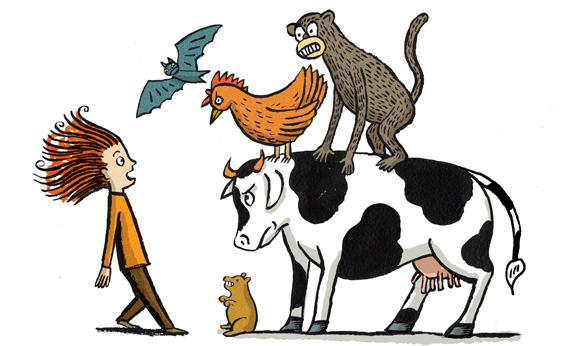 How afraid should you be of animal-borne disease?
How afraid should you be of animal-borne disease?Robert Neubecker.
Everybody knows that pestilences have a way of recurring in the world; yet somehow we find it hard to believe in ones that crash down on our heads from a blue sky.
?Albert Camus, The Plague
In May, 1997, a 3-year-old boy was admitted to an ICU in Hong Kong after suffering from influenza for a week. Two days later, the boy died of pneumonia. His case would have been merely a curiosity if it weren?t for 17 more patients who came down with the illness months later. In all, six people died from a strain of influenza that had never been seen in humans before, dubbed H5N1.
However, H5N1 wasn?t really ?new.? It had caused outbreaks in Scottish chickens in 1959 and British turkeys in 1991. It had killed geese in Guangdong, China, in 1996. But these bird outbreaks weren?t considered important by physicians or researchers on human disease?this was an avian strain of influenza, and it was thought that humans had little to be concerned about. That changed abruptly in 1997, when the human cases led to the destruction of 1.3 million chickens in Hong Kong in an effort to stop the outbreak. That strategy seemed to work in the short term, but H5N1 has since surfaced in more than two dozen countries and caused more than 600 human infections since 1997?almost half of them fatal.
While scientists were closely following the movements of H5N1, another influenza virus?H1N1?snuck up on us in 2009 and spread around the world in a matter of weeks. This was the first influenza pandemic of the 21st century, and like H5N1, it moved to humans from animals?in this case, from pigs.
When new infectious diseases are discovered, one of the first questions is ?where did this come from?? More often than not, the answer is one of our animal friends?a kind of disease called a zoonosis. Studies have shown that about 75 percent of emerging infectious diseases (diseases that are newly discovered, are increasing in frequency, or have moved into a new geographic area) are of animal origin, as are 60 percent of all known pathogens. Even diseases that have spread freely in the human population, such as tuberculosis, HIV, measles, and smallpox, have their roots in infections carried by animals.
Which animals are the most likely to harbor zoonotic pathogens?
For reasons that are not currently understood, bats are able to be infected with a huge variety of viruses. They pass these viruses to other animal species via bites or guano. The classic bat-origin virus is rabies, but bats have also been implicated as possible reservoir species for the Ebola and Marburg viruses, Nipah, Hendra, and others. Even influenza has recently been found in bats. Bats also appear to be the reservoir for the SARS coronavirus, which surfaced in 2002 in Asia. SARS eventually infected more than 8,000 individuals around the world and killed almost 800 of them between November 2002 and July 2003, spreading to at least 37 countries. A new SARS-related virus has recently surfaced in Saudi Arabia, and speculation is that it?s also from bats.
While bats appear to be responsible for a disproportionate amount of novel pathogens, every animal species carries its own unique microbiota?the collection of microbes that live on and in an animal?s body. Some of those can also spread to humans. As mentioned above, birds can spread many different types of influenza viruses. In fact, wild waterfowl serve as the ultimate reservoir for all known types of influenza viruses. Birds also can transmit a number of encephalitis viruses, such as West Nile. Because many migrate long distances, birds may be particularly efficient at introducing pathogens into new areas.
Primates also harbor a number of pathogens that have crossed over into human populations, often an easy jump since we are so closely related. HIV is the result of multiple species jumps from nonhuman primates into human populations, likely due to butchering of infected animals. Research carried out by Nathan Wolfe and others has shown that bushmeat hunters in Africa are still being infected with viruses from our primate relatives.
Source: http://feeds.slate.com/click.phdo?i=1ad0361da554a0901f4ee15ad8cffd07
super bowl snacks appleton super bowl recipes denver weather planned parenthood what time does the superbowl start kobayashi
No comments:
Post a Comment
Note: Only a member of this blog may post a comment.